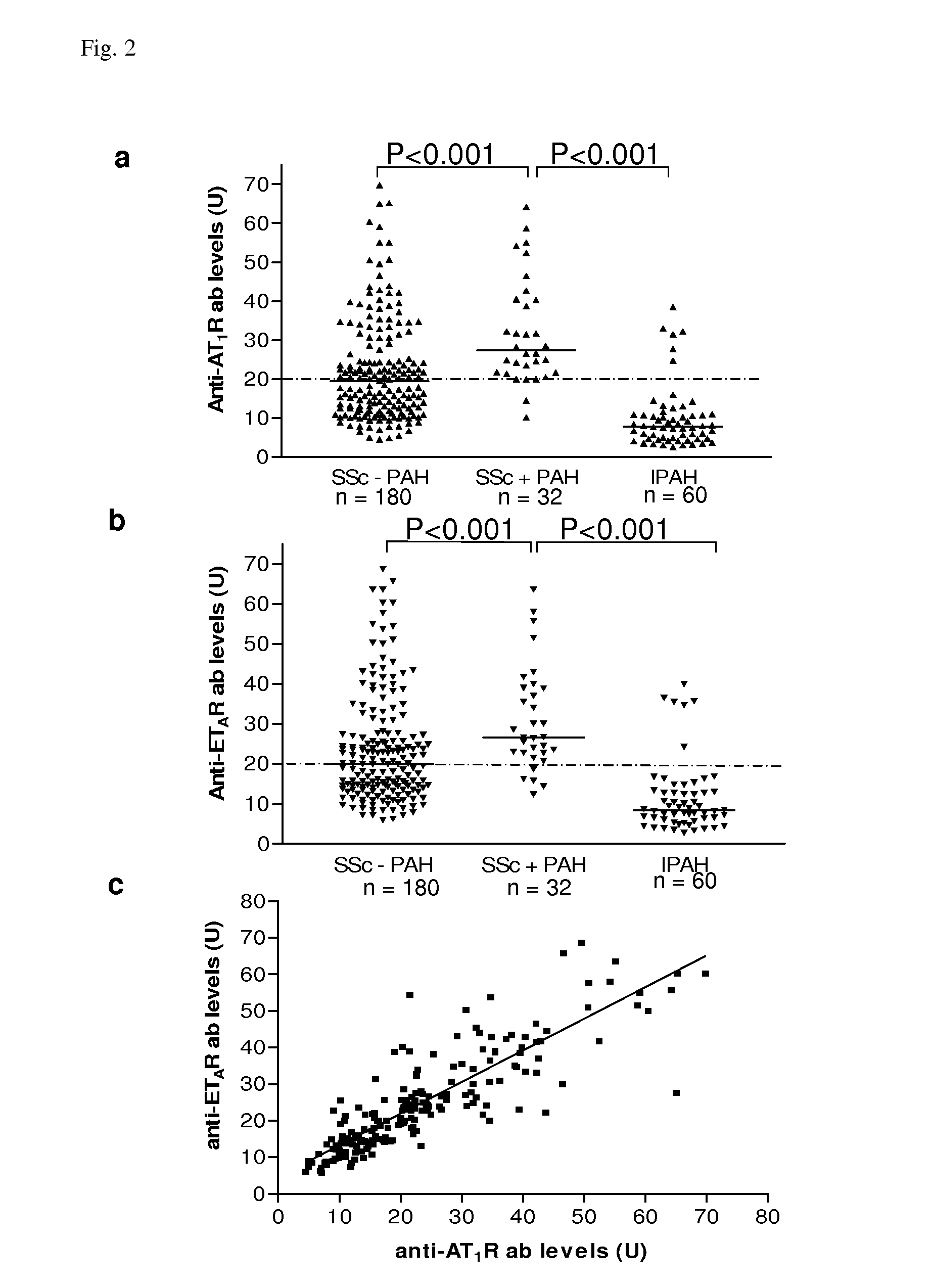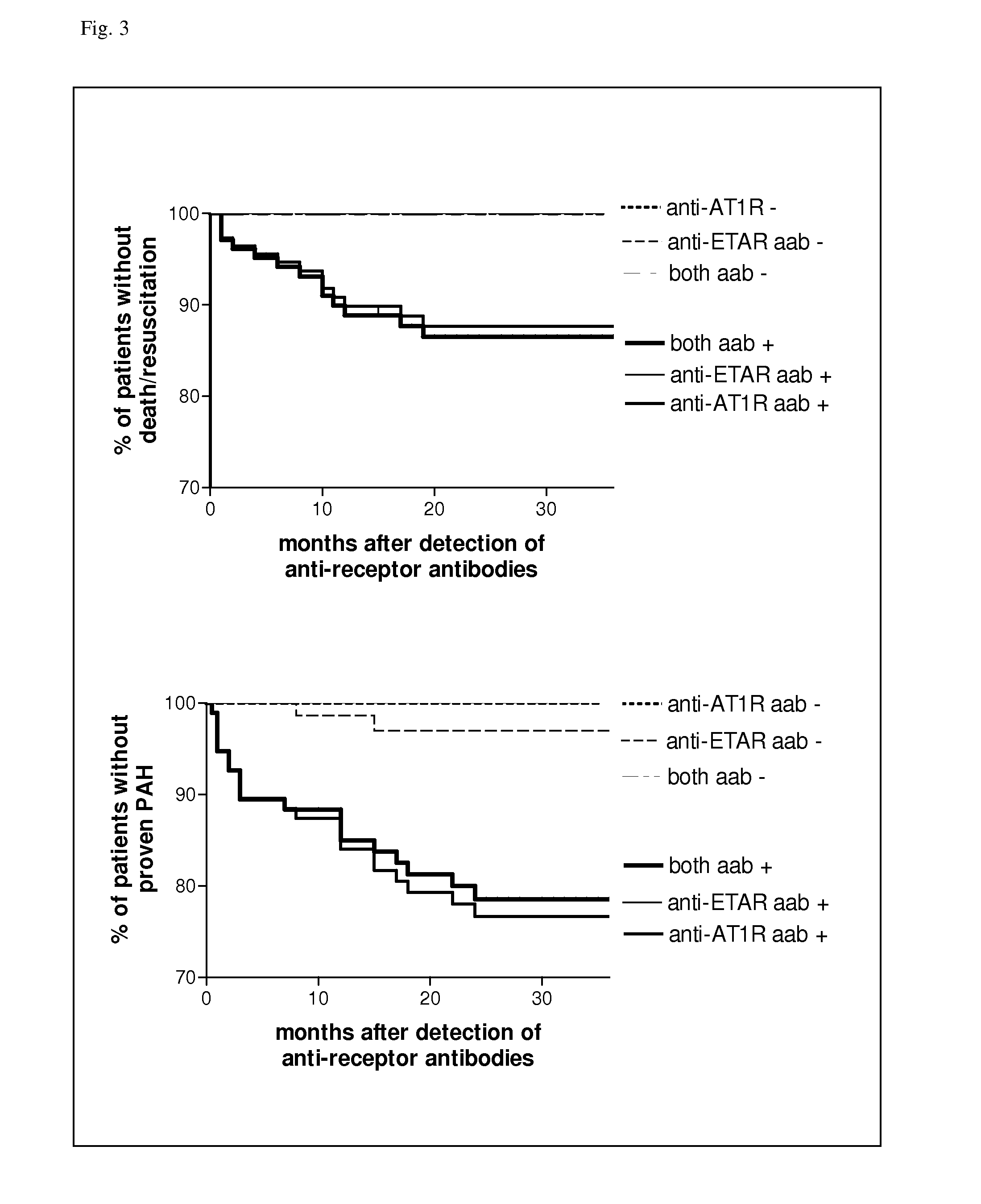Method for diagnosis of a disease involving an Anti-endothelin-receptor antibody
a technology of anti-endothelin receptor and immunology, applied in the field of biochemistry, can solve the problems of difficult diagnosis of pre-eclampsia, and regarded as very serious conditions both pre-eclampsia and pih
- Summary
- Abstract
- Description
- Claims
- Application Information
AI Technical Summary
Benefits of technology
Problems solved by technology
Method used
Image
Examples
example i
Endothelin-Receptor ELISA
[0109]A suitable streptavidine-coated microtiter plate is loaded with the biotinylated peptide encoding the endothelin-receptor. To this end, 100 μl of a solution per well in the microtiter plate is incubated with 5 μg / ml in a suitable dilution buffer. To measure the non-specific binding, wells are also filled with 100 μl of dilution buffer. The dilution buffer may comprise 0.5% bovine serum albumin, 10 mM phosphate buffer (pH 7.4), 140 mM NaCl and 0.05% TWEEN 20.
[0110]Subsequent to the time period of reaction, the peptide solution is moved by decanting and each well is washed three times with 250 μl of a suitable wash buffer. A suitable wash buffer may comprise 10 mM phosphate buffer (pH 7.4), 140 mM NaCl and 0.1% TWEEN 20. Thereafter, 100 μl per well of sera are diluted in a dilution buffer and placed on both the peptide-loaded and comparative plates are incubated. Subsequently, the wells are washed as described above.
[0111]The bound antibodies are detecte...
example ii
[0113]Various patient groups (with positive diagnosis) as well as controls were tested with respect to the presence or absence of the anti-endothelin-receptor antibody. Table I shows the result obtained.
TABLE IDetection of anti-endothelin-receptor antibody in blood samples ofHealthy controls, control diseases, SSc patients, inflammatorydisease patients and patients with graft rejectionsPresence of anti-endothelin-receptorDiseaseanti-body in %Healthy controls2.8Control diseases10.8SSc57.5Inflammatory disease35Patients with graft rejection95Patients without graft rejection6.2
example iii
[0114]The invention also relates to a method for a removal of anti-endothelin-receptor antibodies from isolated blood, wherein in a first step the presence or absence of an anti-endothelin-receptor antibody is determined in a blood sample from a patient to be diagnosed wherein the patient is thought to have a disease selected from the group of graft rejection, Raynaud-Syndrom (Morbus Raynaud), diabetes, pre-eclampsia, hypertension, vasculitis, collagenosis, an inflammatory rheumatic disease and arteriosclerosis, and wherein, upon determination the presence of an anti-endothelin-receptor antibody the blood of the patient is subjected to a plasmapheresis. Isolated blood from patients thought to have systemic sclerosis were analysed for the presence on an anti-endothelin-receptor antibody. In both patients the presence of an anti-endothelin antibody was conformed. The isolated blood was subjected to plasmapheresis. Thereupon, the isolated blood was resubjected to the patients. The tigh...
PUM
| Property | Measurement | Unit |
|---|---|---|
| pH | aaaaa | aaaaa |
| wedge pressure | aaaaa | aaaaa |
| wedge pressure | aaaaa | aaaaa |
Abstract
Description
Claims
Application Information
 Login to View More
Login to View More - R&D
- Intellectual Property
- Life Sciences
- Materials
- Tech Scout
- Unparalleled Data Quality
- Higher Quality Content
- 60% Fewer Hallucinations
Browse by: Latest US Patents, China's latest patents, Technical Efficacy Thesaurus, Application Domain, Technology Topic, Popular Technical Reports.
© 2025 PatSnap. All rights reserved.Legal|Privacy policy|Modern Slavery Act Transparency Statement|Sitemap|About US| Contact US: help@patsnap.com



